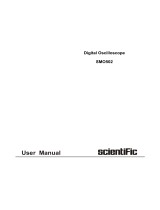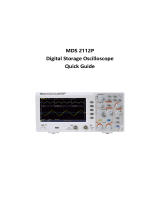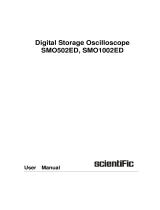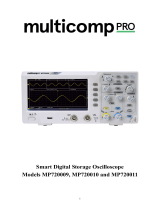
I
User‘s Manual
Digital Storage Oscilloscope
ADS-5072/ADS-5102/ADS-5202/ADS-5302
ADS-5074/ADS-5104/ADS-5204/ADS-5304
AHS-2062
I
I
I
I
I
I
I
I
I
I
I
I
I
I
I
I
I
I
I
I
I
I
I
I
I
I
I
I
I
I
I
I
I
I
I
I
I
I
I
I
I
I
I
I
I
I
I
I
I
I
I
I
I
I
I
I
I
I
I
I
I
I
I
I
I
I
I
I
I
I
I
I
I
I
I
I
I
I
I
I
I
I
I
I
I
I
I
I
I
I
I
I
I
I
I
I
I
I
I
I
I
I
I
I
I
I
I
I
I
I
I
I
I
I
www.tmatlantic.com

III
Digital Storage Oscilloscope Brief Introduction
Model:
500MSa/s real-time sampling rate Series Bandwidth: 60MHZ,
1GSa/s real-time sampling rate Series Bandwidth: 70MHZ,100MHZ, 200MHZ 300MHZ
2GSa/s real-time sampling rate Series Bandwidth: 70MHZ,100MHZ, 200 MHz,300MHz
Characteristic:
The volume of the oscilloscope is cabinet and it is portable
Color TFT LCD display
Single real-time sampling rate are 500MSa/s or 1Gsa/s or 2Gsa/s;
Memory depth are 4Kpts&32 Kpts(500MSa/s real-time sampling rate),
5Kpts&40Kpts&2Mpts (1GSa/s real-time sampling rate)
18Kpts& 24Kpts(2GSa/s real-time sampling rate)
Edge, Pulse, VideoˈSlopeˈand Alternative trigger function.
Unique Digital Filter function and Waveform recorder function
Pass/Fail function.
Auto measure thirty two parameters support all measurement function.
Two groups’ & Four groups’ reference waveforms and twenty groups’ capture
waveforms and twenty groups’ setups internal save/recall function and USB flash
drive save/recall function.
Cursor measure covers Manual mode, Track mode and Auto mode.
Channel waveform and its FFT waveform display on split screen.
Waveform Intensity and Grid Brightness can be adjusted.
Menu display in the form of pop-up that in order to convenience users to use it.
Rich Screen display styles: Classical, Modern, Tradition, Succinct.
Multiple Language User Interface.

IV
Support Multilingual help system online
Standard setup interface: USB Host: Support USB flash drive storage/recall
function and update firmware; USB Device: Support PictBridge compatible printer
and support PC remote control; RS-232/ RJ-45 Connector ;Pass/Fail output
Digital Storage Oscilloscope Accessories:
1:1/10:1 probe (2 PCS&4 PCS, According to the number of channel)
Power Cable that fits the standard of destination country
Certification.
guaranty card
CD(including EasyScope3.0 computer software system)
User Manual
USB cable

General safety summary
V
General Safety Summary
Review the following safety precautions to avoid injury and prevent damage to
this product or any products connected to it. To avoid potential hazards, use this
product only as specified.
Only qualified personnel should perform service procedures.
1. To Avoid Fire or Personal Injury
ƽ
Use Proper Power Cord. Use only the power cord specified for this product and
certified for the country of use.
ƽ
Connect and Disconnect Properly. Do not connect or disconnect probes or test
leads while they are connected to a voltage source.
ƽ
Ground the Product. This product is grounded through the grounding conductor
of the power cord. To avoid electric shock, the grounding conductor must be
connected to earth ground. Before making connections to the input or output
terminals of the product, ensure that the product is properly grounded.
ƽ
Connect the Probe Properly. The probe ground lead is at ground potential. Do
not connect the ground lead to an elevated voltage.
ƽ
Observe All Terminal Ratings. To avoid fire or shock hazard, observe all
ratings and marking on the product. Consult the product manual for further ratings
information before making connections to the product.
ƽ
Do Not Operate Without Covers. Do not operate this product with covers or
panels removed.
ƽ
Use Proper Fuse. Use only the fuse type and rating specified for this product.

VI
ƽ
Avoid Exposed Circuitry. Do not touch exposed connections and components
when power is present.
ƽ
Do Not Operate With Suspected Failures. If you suspect there is damage to this
product, have it inspected by qualified service personnel.
ƽ
Do Not Operate in Wet/Damp Conditions.
ƽ
Do Not Operate in an Explosive Atmosphere.
ƽ
Keep Product Surfaces Clean and Dry.
Power Line Conducted Emission Limits(Class B)
Measuring standard:EN61326:1998+A1,2002+A2,2003
Safety Terms and Symbols
Terms on the Product. These terms may appear on the product:
DANGER: Indicates an injury hazard immediately accessible as you read the
marking.
WARNING: Indicates an injury hazard not immediately accessible as you read the
marking.
CAUTION: indicates a hazard to property including the product.
Symbols on the Product. These symbols may appear on the product:
Warning
Protective Ground Caution Earth Terminal
high voltage (Earth) Terminal Refer to Manual

preface
VII
Preface
This manual contains operating information for the Digital Storage
Oscilloscopes. The manual consists of the following chapters:
ƹ “Accidence” chapter describes the front panel; display area of the oscilloscope;
Functional Check and Probe Compensation briefly.
ƹ “Functions Instruction and Operation” chapter describes function and operation of
the Oscilloscope systemically.
ƹ “Application Examples” chapter includes examples of a wide variety of
measurements to give you ideas on how to solve your measure problems.
ƹ “Prompting messages and Troubleshooting” chapter describes prompting
messages and describes some ways of troubleshooting.
ƹ “Service and Support” chapter introduce warranty and technology of the products.
ƹ “Appendix A: Specifications” chapter introduce specifications of the oscilloscopes
ƹ “Appendix B: Oscilloscope Accessories” chapter briefly describes standard
accessories.
ƹ “Appendix C: Default Setup” chapter contains a list of the menus and controls
with the default (factory) settings that are recalled when you push the DEFAULT
SETUP front-panel button.
ƹ “Appendix D: Daily Maintain and Cleaning” chapter describes how to take care of
the oscilloscope.


1
Catalogue
Storage Digital Oscilloscope introduction....................................................................... II
General Safety Requirement................................... ............................ ….....................IV
Preface............................................................................................................................VI
User Manual .....................................................................................................................I
Digital Storage Oscilloscope Brief Introduction ......................................................... III
Chapter 1 Accidence ......................................................................................................... 3
1.1 Accidence of the front panel and user interface..................................................4
1.2 Function checking...............................................................................................8
1.3 Probe...................................................................................................................9
1.3.1 Probe Safety.....................................................................................................9
1.3.2 Probe Attenuation Setting................................................................................9
1.3.3 Probe Compensation......................................................................................10
Chapter 2 Functions Instruction and Operation.......................................................... 12
2.1 Menu and control button...................................................................................12
2.2 Connector..........................................................................................................14
2.3 Auto setup .........................................................................................................15
2.4 Default setup.....................................................................................................17
2.5 Universal knob..................................................................................................18
2.6 Vertical System .................................................................................................19
2.6.1 CH1 & CH2 Channel.....................................................................................19
2.6.2 The Using of the Vertical “Position” knob and “Volt/div” knob in the vertical
system .....................................................................................................................
26
2.6.3 Math Functions ..............................................................................................27
2.6.4 Using Ref.......................................................................................................34
2.7 Horizontal System ............................................................................................36
2.7.1 Horizontal control knob.................................................................................37
2.7.2 Window Zone.................................................................................................37
2.8 Trigger System..................................................................................................40
2.8.1 Signal Source.................................................................................................41
2.8.2 Trigger Type...................................................................................................41
2.8.3 Coupling ........................................................................................................53
2.8.4 Position ..........................................................................................................53
2.8.5 Slope & Level ................................................................................................53
2.8.6 Trigger Holdoff...........................................................................................54
2.9 Acquiring Signals system .................................................................................55
2.10 Display System ...............................................................................................60
2.10.1 X-Y Format..................................................................................................63
2.11 Measure System..............................................................................................65
2.11.1 Scale Measurement ......................................................................................65
2.11.2 Cursor Measurement....................................................................................65
2.11.3 Auto Measurement .......................................................................................70
2.12 Storage System ...............................................................................................76
2.13 Utility System .................................................................................................87
2.13.1 System status ...............................................................................................90
2.13.2 Language......................................................................................................91
2.13.3 Print .............................................................................................................91
2.13.4 Self Calibration............................................................................................94
2.13.5 Self Test .......................................................................................................95

2
2.13.6 Update Firmware .........................................................................................97
2.13.7 Pass/Fail.......................................................................................................97
2.13.8 Waveform Record ......................................................................................101
2.13.9 Recorder.....................................................................................................104
2.14 Online Help Function .................................................................................107
Chapter3 Application Examples.................................................................................. 108
3.1Taking Simple Measurements .........................................................................109
3.2 Taking Cursor Measurements......................................................................... 111
3.2.1 Measuring Ring Frequency.......................................................................... 111
3.2.2 Measuring Ring Amplitude ......................................................................... 112
3.3 Catch the single signal .................................................................................... 113
3.4 Analyze the signal detail ................................................................................. 114
3.4.1 Looking at a Noisy Signal ........................................................................... 114
3.4.2 Separating the Signal from Noise ................................................................ 114
3.5 Triggering on a Video Signal.......................................................................... 115
3.5.1Triggering on Video Field ............................................................................ 115
3.5.2 Triggering on Video Lines........................................................................... 115
3.6. Application of X-Y function .......................................................................... 116
3.7 Analyzing a Differential Communication Signal............................................118
Chapter 4 prompting messages and troubleshooting................................................. 119
4.1 Prompting messages: ...................................................................................... 119
4.2 Troubleshooting ..............................................................................................121
Chapter 5 Service and Support.................................................................................... 123
5.1 Maintain summary ..........................................................................................123
Appendix A: Specifications .......................................................................................... 124
Appendix B: Default setup ........................................................................................... 129
Appendix C: Daily Maintain and Cleaning ................................................................ 131
Daily Maintain ....................................................................................................131
Cleaning...............................................................................................................131
Index............................................................................................................................... 132

3
Chapter 1 Accidence
Digital Storage Oscilloscope is mini-type and portable bench type instruments,
which could be used for measuring as the GND voltage.
This Chapter shows you how to operate following tasks:
ƹ Accidence of the front panel and user interface
ƹ Simple checking of functions
ƹ Probe compensation
ƹ Matching probes attenuation coefficient

4
1.1 Accidence of the front panel and user interface
It is important for you to understand the DSO’s front panel before operating it.
The following contents are the brief introduction for the front panel function, which is
useful to be familiar with the operation of the Digital Storage Oscilloscope in short
time.
1.1.1 Front Panel
The oscilloscopes provides an easy-to-use front panel to convenience users to
operate them, the panel contains knobs and buttons. There is a list of five ashen buttons
as menu operational buttons on the right of display screen. You can set different options
of the current menu in virtue of them. Other buttons are function buttons; you can enter
different function menus or obtain given function application in virtue of them.
Picture 1-1 Front Panel Controls(2 Channel model)
Option Button
USB Host
Interface
Signal input
channel
Print
b
utton
EXT Trigger
input channel
Menu
Button
Universal
Knob
Common Function
Button
Run Control
AUTO Button
Vertical Control
Trigger Control
Probe component
Horizontal Control

5
Picture 1-1.1 Front Panel Controls(4 Channel model)
Picture 1-2 Display area(5.7’ LCD model)
Option
Button
Menu
Button
Signal input
channel
Print
b
utton
EXT Trigger
input channel
Universal
Knob
Vertical
Control
Trigger
Control
AUTO
Button
Horizontal
Control
Common Function
Button
USB Host
Interface

6
1. Trigger status
Armed:The oscilloscope is acquiring pre-trigger data. All triggers are ignored in
this state.
Ready: All pre-trigger data has been acquired and the oscilloscope is ready to accept
a trigger.
Trig’d: The oscilloscope has seen a trigger and is acquiring the posttrigger data.
Stop: The oscilloscope has stopped acquiring waveform data.
Auto: The oscilloscope is in auto mode and is acquiring waveforms in the absence of
triggers.
Scan: The oscilloscope is acquiring and displaying waveform data continuously in
scan mode.
2. display the position of the present waveform window
3. Marker shows horizontal trigger position. Turn the HORIZONTAL POSITION
knob to adjust the position of the marker.
4
“Print Key” option is set to “Print Picture”.
“Print Key” option is set to “Save Picture”.
5.
“Back USB” option is set to “Computer”.
“Back USB” option is set to “Printer”.
6. Show the waveform’s channel position.
7. Signal Coupling symbol.
8. Readout shows the vertical factor of the channels.
9. “B” icon shows that bandwidth function is open.
10. Readout shows the main time base setting.
11. Icon shows the trigger type for the triggering
12. Readout shows the horizontal position.
13. Readout shows the trigger voltage.
14. Readout shows present signal frequency.

7
1.1.2 Back and Side Connections
Oscilloscope
Picture 1- 3(2 Channel model)
1ǃ Pass/Fail Output
2ǃ RS-232 Connector
3ǃ Back USB Connector
4ǃ Power Input Connector
Picture 1- 3.1(4 Channel model)
1ǃ Security Lock Receptacle
2ǃ Pass/Fail Output
3ǃ RJ-45 Connector
4ǃ USB Type B and A Receptacles
5ǃ Power Shutoff Switch and Input Connector

8
1.2 Function checking
When you check whether or not the oscilloscope could work smoothly, please
operate as following:
1. Power On the oscilloscope.
Press “DEFAULT SETUP” to show the result of the self check. The probe default
attenuation is 1X.
2. Set the switch to 1X on the probe and connect the probe to channel 1 on the
oscilloscope. To do this, align the slot in the probe connector with the key on the CH
1 BNC, push to connect, and twist to the right to lock the probe in place. Connect the
probe tip and reference lead to the PROBE COMP connectors
Picture 1-4
3ˊPress “AUTO” to show the 1 KHz frequency and about 3V peak-peak square wave
in couple seconds
Picture 1-5
4. Press “CH1” two times to cancel the channel 1, Press“CH2” to change screen into
channel 2, reset the channel 2 as step 2 and 3.

9
1.3 Probe
1.3.1 Probe Safety
A guard around the probe body provides a finger barrier for protection from
electric shock.
Picture 1-6
Connect the probe to the oscilloscope and connect the ground terminal to ground
before you take any measurements.
1.3.2 Probe Attenuation Setting
Probes are available with various attenuation factors which affect the vertical
scale of the signal. The Probe Check function verifies that the Probe attenuation
option matches the attenuation of the probe.
You can push a vertical menu button (such as the CH 1 MENU button), and
select the Probe option that matches the attenuation factor of your probe.
Note˖ To avoid electric shock when using the probe, keep fingers behind the guard
on the probe body.
To avoid electric shock while using the probe, do not touch metallic
portions of the probe head while it is connected to a voltage source.
Connect the probe to the oscilloscope and connect the ground terminal to
ground before you take any measurements.

10
Be sure that the attenuation switch on the probe matches the Probe option in the
oscilloscope. Switch settings are 1X and 10X.
1.3.3 Probe Compensation
As an alternative method to Probe Check, you can manually perform this
adjustment to match your probe to the input channel.
Picture1-7
1
. Set the Probe option attenuation in the channel menu to 10X. Set the switch to 10X
on the probe and connect the probe to channel 1 on the oscilloscope. If you use the
probe hook-tip, ensure a proper connection by firmly inserting the tip onto the
probe.
2.
Attach the probe tip to the PROBE COMP̚3V connector and the reference lead
to the PROBE COMP Ground connector. Display the channel and then push the
“AUTO” button.
Note. The default setting for the Probe option is 1X.
Note. When the attenuation switch is set to 1X, the probe limits the bandwidth of the
oscilloscope to 10MHz. To use the full bandwidth of the oscilloscope, be sure to set the
switch to 10X

11
3. Check the shape of the displayed waveform.
under compensated Compensated correctly over compensated
Picture 1-8
4. If necessary, adjust your probe. Repeat as necessary.

12
Chapter 2 Functions Instruction and Operation
To use your oscilloscope effectively, you need to learn about the following
oscilloscope functions:
ƹ Menu and control button
ƹ Connector
ƹ Auto Setup
ƹ Default Setup
ƹ Universal knob
ƹ Vertical System
ƹ Horizontal System
ƹ Trigger System
ƹ Acquiring signals System
ƹ Display System
ƹ Measuring waveforms System
ƹStorage System
ƹUtility System
ƹ Online Help function
2.1 Menu and control button
Showing as the following picture:

13
Picture 2-1
All models:
CH1
ǃ
CH2: Channel 1, channel 2 menu control button.
MATH: MATH function control button.
REF: Reference waveforms control button.
HORI MENU: Horizontal control button.
TRIG MENU: Trigger control button.
SET TO 50%: Set the trigger level to midpoint of the signal amplitude.
FORCE: Use the FORCE button to complete the current waveform acquisition
whether the oscilloscope detects a trigger or not. This is useful for Single
acquisitions and Normal trigger mode.
SAVE/RECALL: Display the Save/Recall Menu for setups and waveforms.
ACQUIRE: Display the Acquire Menu.
MEASURE: Display the automated measurements menu.
CURSORS: Display the Cursor Menu. Vertical Position controls adjust cursor
position while displaying the Cursor Menu and the cursors are activated.
Cursors remain displayed (unless the “Type” option is set to “Off”) after
leaving the Cursor Menu but are not adjustable.
DIS PLAY: Display the Display Menu.
UTILITY: Display the Utility Menu.
DEFAULT SETUP: Recall the factory setup.
HELP: Enter the online help system.
AUTO: Automatically sets the oscilloscope controls to produce a usable display of
the input signals.
RUN/STOP: Continuously acquires waveforms or stops the acquisition.
Note˖If waveform acquisition is stopped (using the RUN/STOP or SINGLE
Page is loading ...
Page is loading ...
Page is loading ...
Page is loading ...
Page is loading ...
Page is loading ...
Page is loading ...
Page is loading ...
Page is loading ...
Page is loading ...
Page is loading ...
Page is loading ...
Page is loading ...
Page is loading ...
Page is loading ...
Page is loading ...
Page is loading ...
Page is loading ...
Page is loading ...
Page is loading ...
Page is loading ...
Page is loading ...
Page is loading ...
Page is loading ...
Page is loading ...
Page is loading ...
Page is loading ...
Page is loading ...
Page is loading ...
Page is loading ...
Page is loading ...
Page is loading ...
Page is loading ...
Page is loading ...
Page is loading ...
Page is loading ...
Page is loading ...
Page is loading ...
Page is loading ...
Page is loading ...
Page is loading ...
Page is loading ...
Page is loading ...
Page is loading ...
Page is loading ...
Page is loading ...
Page is loading ...
Page is loading ...
Page is loading ...
Page is loading ...
Page is loading ...
Page is loading ...
Page is loading ...
Page is loading ...
Page is loading ...
Page is loading ...
Page is loading ...
Page is loading ...
Page is loading ...
Page is loading ...
Page is loading ...
Page is loading ...
Page is loading ...
Page is loading ...
Page is loading ...
Page is loading ...
Page is loading ...
Page is loading ...
Page is loading ...
Page is loading ...
Page is loading ...
Page is loading ...
Page is loading ...
Page is loading ...
Page is loading ...
Page is loading ...
Page is loading ...
Page is loading ...
Page is loading ...
Page is loading ...
Page is loading ...
Page is loading ...
Page is loading ...
Page is loading ...
Page is loading ...
Page is loading ...
Page is loading ...
Page is loading ...
Page is loading ...
Page is loading ...
Page is loading ...
Page is loading ...
Page is loading ...
Page is loading ...
Page is loading ...
Page is loading ...
Page is loading ...
Page is loading ...
Page is loading ...
Page is loading ...
Page is loading ...
Page is loading ...
Page is loading ...
Page is loading ...
Page is loading ...
Page is loading ...
Page is loading ...
Page is loading ...
Page is loading ...
Page is loading ...
Page is loading ...
Page is loading ...
Page is loading ...
Page is loading ...
Page is loading ...
Page is loading ...
Page is loading ...
Page is loading ...
Page is loading ...
-
 1
1
-
 2
2
-
 3
3
-
 4
4
-
 5
5
-
 6
6
-
 7
7
-
 8
8
-
 9
9
-
 10
10
-
 11
11
-
 12
12
-
 13
13
-
 14
14
-
 15
15
-
 16
16
-
 17
17
-
 18
18
-
 19
19
-
 20
20
-
 21
21
-
 22
22
-
 23
23
-
 24
24
-
 25
25
-
 26
26
-
 27
27
-
 28
28
-
 29
29
-
 30
30
-
 31
31
-
 32
32
-
 33
33
-
 34
34
-
 35
35
-
 36
36
-
 37
37
-
 38
38
-
 39
39
-
 40
40
-
 41
41
-
 42
42
-
 43
43
-
 44
44
-
 45
45
-
 46
46
-
 47
47
-
 48
48
-
 49
49
-
 50
50
-
 51
51
-
 52
52
-
 53
53
-
 54
54
-
 55
55
-
 56
56
-
 57
57
-
 58
58
-
 59
59
-
 60
60
-
 61
61
-
 62
62
-
 63
63
-
 64
64
-
 65
65
-
 66
66
-
 67
67
-
 68
68
-
 69
69
-
 70
70
-
 71
71
-
 72
72
-
 73
73
-
 74
74
-
 75
75
-
 76
76
-
 77
77
-
 78
78
-
 79
79
-
 80
80
-
 81
81
-
 82
82
-
 83
83
-
 84
84
-
 85
85
-
 86
86
-
 87
87
-
 88
88
-
 89
89
-
 90
90
-
 91
91
-
 92
92
-
 93
93
-
 94
94
-
 95
95
-
 96
96
-
 97
97
-
 98
98
-
 99
99
-
 100
100
-
 101
101
-
 102
102
-
 103
103
-
 104
104
-
 105
105
-
 106
106
-
 107
107
-
 108
108
-
 109
109
-
 110
110
-
 111
111
-
 112
112
-
 113
113
-
 114
114
-
 115
115
-
 116
116
-
 117
117
-
 118
118
-
 119
119
-
 120
120
-
 121
121
-
 122
122
-
 123
123
-
 124
124
-
 125
125
-
 126
126
-
 127
127
-
 128
128
-
 129
129
-
 130
130
-
 131
131
-
 132
132
-
 133
133
-
 134
134
-
 135
135
-
 136
136
-
 137
137
-
 138
138
-
 139
139
Aktakom ADS-5204 User manual
- Category
- Measuring, testing & control
- Type
- User manual
Ask a question and I''ll find the answer in the document
Finding information in a document is now easier with AI
Related papers
-
Aktakom ADS-2022 User manual
-
Aktakom ADS-2022 User manual
-
Aktakom ADS-4102 User manual
-
Aktakom ADS-2332 User manual
-
Aktakom ADS-4222 User manual
-
Aktakom ADS-2071MV User manual
-
Aktakom ADS-2121M User manual
-
Aktakom ADS-2031V User manual
-
Aktakom ADS-2121M Installation guide
-
Aktakom AFC-2500 User manual
Other documents
-
 Scientific SMO502 Owner's manual
Scientific SMO502 Owner's manual
-
 Hantek Hantek6022BL User manual
Hantek Hantek6022BL User manual
-
 Hantek 6102 User manual
Hantek 6102 User manual
-
PeakTech P 1400 Owner's manual
-
SIGLENT SDS1000CNL+ Series Digital Storage Oscilloscope User manual
-
 MUSTOOL Digital Storage Oscilloscope User guide
MUSTOOL Digital Storage Oscilloscope User guide
-
SIGLENT SDS1000CFL Series Digital Storage Oscilloscope User manual
-
OWON XDS Series n-in-1 DSO Quick start guide
-
 Scientific SMO502ED Owner's manual
Scientific SMO502ED Owner's manual
-
 multicomp pro MP720011 EU-UK Operating instructions
multicomp pro MP720011 EU-UK Operating instructions
















































































































































